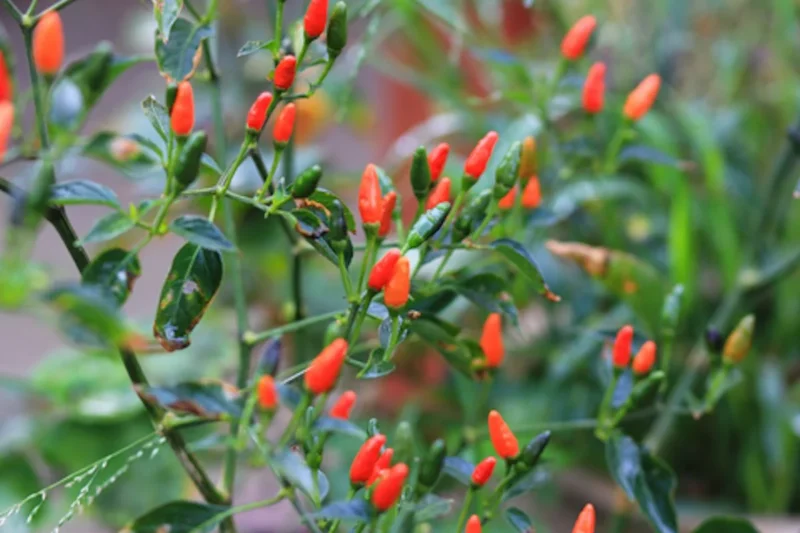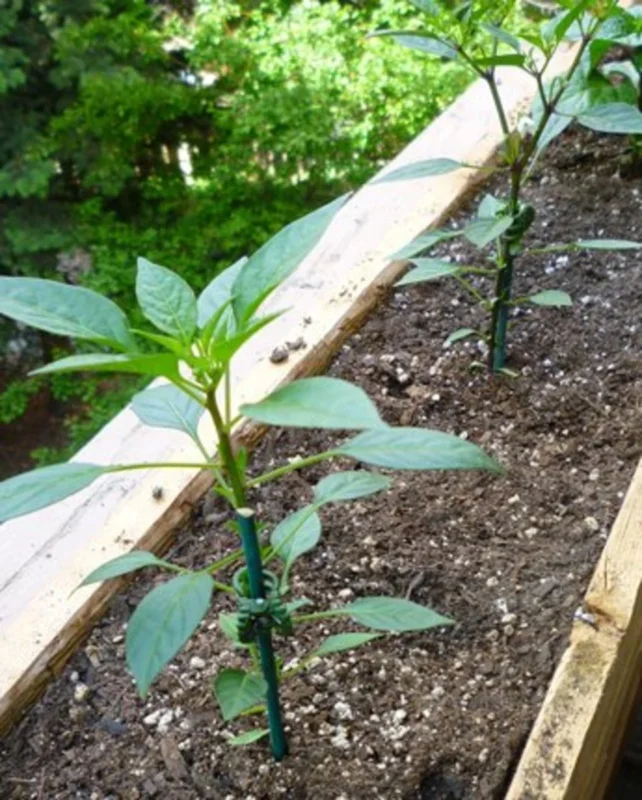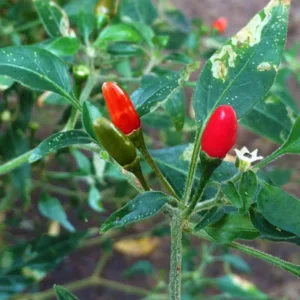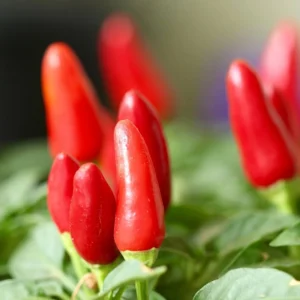If you’re a chili enthusiast who loves a fiery kick in a small package, you might consider growing pequin pepper (Capsicum annuum ‘Pequin’). These tiny, oval-shaped peppers measure just 1/2 to 3/4 inches long but pack an intense heat with a Scoville rating ranging from 30,000 to 60,000. Known for their smoky and slightly citrusy flavor, pequin peppers are perfect for spicing up salsas, soups, and marinades.
These peppers grow on bushy plants that reach about 2 feet tall, making them an excellent choice for container gardening or small spaces. This heat-loving chili is a culinary delight and a decorative plant, with vibrant green foliage and bright red fruits at maturity. With a growing season of 90 to 120 days, pequin peppers flourish in warm, sunny climates, making them a rewarding addition for chili lovers and gardeners alike. Whether you’re a spice enthusiast or a gardener, the pequin pepper is a versatile and rewarding plant to grow.
What Are Pequin Peppers?

The pequin pepper (Capsicum annuum ‘Pequin’) is a small yet mighty chili pepper known for its intense heat and distinctive flavor. Native to Mexico, its name comes from the Spanish word “pequeño,” meaning “small,” which perfectly describes these tiny peppers.
They are a popular ingredient in Mexican cuisine, used to flavor sauces, salsas, and pickles. Their dried form, often called “Chile Pequin,” is frequently crushed into powder or flakes to season dishes.
Key Features
Scientific Name: Capsicum annuum ‘Pequin’
Mature Size: 1-2 feet tall, 1-2 feet wide
USDA Growing Zones: 9-11 (can be grown as an annual in cooler zones)
Expected Planting Period: Spring, after the last frost date
Growth Rate: Moderate during the growing season
Fruit Characteristics: Tiny, oval-shaped peppers (1/2 to 3/4 inch long) that ripen from green to vibrant red. Both decorative and edible, with bright red fruits and bushy green foliage
Planting Pequin pepper
Pequin peppers are a fantastic choice if you’re looking to add some fiery flavor and charm to your garden or patio. Whether you’re growing them from Pequin pepper seeds or purchasing a young Chile Pequin plant for sale, these peppers are versatile and rewarding. But how do you plant them successfully? Let’s break it down step by step
1. Choosing the Right Location
Pequin peppers love the sun—like, really love it. So, pick a spot in your garden that gets at least 6-8 hours of direct sunlight every day. If you’re growing them in a container, make sure you can easily move the pot to a sunny spot.
Pro Tip: These peppers thrive in warm, dry climates, so if you live in a cooler area, consider growing them indoors or in a greenhouse.
2. Soil Preparation
Pequin peppers aren’t too fussy about soil, but they do have some preferences:
-
Use well-draining soil rich in organic matter. A mix of garden soil and compost works wonders.
-
Maintain a pH level of 6.0 to 7.0 (neutral to slightly acidic).
Before planting, loosen the soil and remove any weeds. Adding a layer of mulch can help retain moisture and prevent weeds from growing later.
3. Planting Seeds or Transplants
Here’s where the magic happens!
For seeds
-
Pequin peppers have a long growing season (90-120 days), so it’s best to start the seeds indoors about 6-8 weeks before the last frost date in your area.
-
Use seed-starting trays or small pots with sterile seed-starting mix. This ensures good drainage and prevents diseases.
-
Sow the seeds about 1/4 inch deep into the soil and lightly cover them.
-
Mist the soil gently with water to keep it moist but not waterlogged.
-
Place the trays or pots in a warm location. Pequin pepper seeds need warmth to germinate, ideally around 75-85°F. Using a heat mat can help if your home is cooler.
-
Pequin seeds can take 7-21 days to germinate, so don’t worry if they take a little time.
-
Once the seedlings appear, place them in a sunny spot or under grow lights for at least 12-16 hours of light daily.
-
When the seedlings are 4-6 inches tall and have developed several sets of true leaves, they’re ready to move outdoors.
-
Hardening Off: Before transplanting, acclimate your seedlings to outdoor conditions by placing them outside for a few hours each day over a week. This prevents transplant shock.
For transplants

-
Space them about 18-24 inches apart in the garden. This gives the plants enough room to grow and spread.
-
Carefully remove the transplant from its pot, being mindful not to damage the roots.
-
Place the plant in the hole so that the top of the root ball is level with the soil surface.
-
Fill in around the plant with soil, pressing gently to remove air pockets.
-
Give your newly planted Pequin peppers a good soak to help the roots establish.
-
Add a layer of mulch around the base of the plant to retain moisture and keep weeds at bay.
Quick Reminder: Pequin peppers have a long growing season (90-120 days), so patience is key!
4. Container Planting Tips
If you don’t have a garden, no worries! Pequin peppers grow beautifully in containers.
-
Choose a 12-inch or larger pot with good drainage holes.
-
Use high-quality potting soil and mix in some compost or slow-release fertilizer.
-
Water consistently but avoid overwatering. The soil should be damp, not soggy.
Bonus Tip: Container peppers can be moved indoors if the weather turns cold, letting you enjoy fresh peppers longer.
Read more: 12 Tips for Growing Pequin Peppers Indoors
Caring for Pequin Peppers
Taking proper care of your pequin peppers ensures they grow strong and produce a spicy, abundant harvest.
1. Watering
Pequin peppers thrive with consistent moisture, but overwatering can be their downfall. Water your plants deeply, about 1-2 times a week, depending on how quickly the soil dries out. In hot weather, you might need to water more frequently.
To check if it’s time to water, stick your finger into the soil about an inch deep. If it feels dry, give the plants a good soak. Always water early in the morning so the leaves can dry during the day, reducing the risk of fungal issues. For container plants, ensure the pot has drainage holes to prevent soggy soil, which can cause root rot.
2. Fertilizing
Pequin peppers are nutrient-hungry plants, so fertilizing them at the right time is key. At planting, mix a balanced fertilizer, like 10-10-10, into the soil to provide a good nutrient base.
As the plants grow, switch to a nitrogen-rich fertilizer every 3-4 weeks to support healthy foliage and stems. Once the peppers start flowering, use a fertilizer with higher phosphorus levels (like 5-10-10) to encourage blooms and fruiting. If you prefer organic options, compost or fish emulsion can be applied every 2-3 weeks for steady growth.
3. Mulching
Mulching is a simple way to keep your pequin pepper plants happy. Spread a 2-3 inch layer of organic mulch, such as straw, shredded leaves, or bark, around the base of your plants. This helps retain moisture, regulate soil temperature, and prevent weeds from competing for nutrients.
Make sure to leave a small gap around the stem to prevent the mulch from trapping moisture directly against the plant, which could cause rot. Mulching is beneficial during hot summer months or in areas where the soil tends to dry out quickly.
4. Pruning and Maintenance
Keeping your pequin pepper plants tidy and well-maintained boosts productivity and prevents common problems. Start by removing any yellow or damaged leaves to promote healthy growth. If your plant becomes too bushy, lightly prune some of the foliage to improve airflow and sunlight penetration.
For younger plants, pinching off the first few flowers helps direct the plant’s energy into growing stronger roots and stems before focusing on fruit production. If the plant becomes heavy with peppers, use a stake or cage to provide support and prevent it from toppling over.
Keep an eye out for pests like aphids or spider mites. These can be treated with insecticidal soap or neem oil. Additionally, avoid letting water sit on the leaves for too long to reduce the risk of fungal diseases.
Finally, pick ripe peppers regularly to encourage the plant to keep producing more. With consistent care, you’ll enjoy a vibrant, flavorful harvest of pequin peppers that will spice up your meals and brighten your garden!
Common Problems and How to Solve Them

Pequin pepper plants can attract several sap-sucking insects, including aphids, spider mites, and whiteflies. If spotted early, these pests can often be managed with a strong spray of water to knock them off the plant. For larger infestations, treat with a mild soap and water solution or neem oil to keep the population under control.
A more serious pest to watch for is the pepper weevil, particularly in warmer regions like the southern U.S. This insect lays its eggs in flowers and developing peppers, and the larvae tunnel through the plant, ruining the fruit. Unfortunately, once the fruit is damaged, insecticides are ineffective. Promptly remove and dispose of any fallen fruit, and practice good garden hygiene. Rotate crops yearly and avoid planting peppers in areas where other solanaceous plants (like tomatoes, eggplants, or potatoes) were grown within the past two years.
Pequin peppers are also susceptible to fungal, bacterial, and viral diseases, such as verticillium wilt, bacterial spot, cercospora leaf spot, powdery mildew, and mosaic viruses like pepper or tobacco mosaic virus. Fungicides can help manage fungal issues, but there is no effective treatment for viral infections.
To reduce the risk of these problems:
-
Use disease-resistant seeds or seedlings whenever possible.
-
Ensure proper air circulation around the plants by spacing them appropriately.
-
Avoid overhead watering to minimize moisture on the leaves, which can encourage fungal growth.
Harvesting Pequin Pepper
Pequin peppers can be harvested when they transition from green to their vibrant red stage. While you can pick them green, waiting until they’re fully red ensures maximum heat and their signature smoky, citrusy flavor. These tiny peppers are ready to harvest when they feel firm and easily snap off with gentle pressure.

For best results, use a pair of scissors or garden snippers to cut the peppers from the plant, keeping the stems intact. This prevents the peppers from deteriorating too quickly after picking and keeps your plant healthy for continued production. Regular harvesting also encourages the plant to produce more peppers throughout the season!
Growing Pequin Peppers Indoors
Yes, you can grow Pequin peppers indoors! These compact plants are perfect for a sunny windowsill, a small indoor garden, or even under grow lights. Whether you want to enjoy their fiery fruits year-round or simply add a decorative touch to your home, here’s how to grow Pequin peppers indoors successfully:
1. Choose the Right Pot and Soil
-
-
Use a container that’s at least 12 inches wide with drainage holes to prevent soggy roots.
-
Fill it with a high-quality potting mix that drains well but retains enough moisture for consistent growth.
-
2. Provide Adequate Light
-
-
Pequin peppers need 6-8 hours of bright sunlight daily. A south-facing window is ideal.
-
If natural light is limited, use full-spectrum grow lights to provide the intensity they need for fruit production.
-
3. Control Temperature and Humidity
-
-
Maintain indoor temperatures between 70-85°F, as peppers love warmth.
-
If your home is dry, consider using a humidity tray or a small humidifier to keep the air around your plant slightly moist.
-
4. Water and Fertilize Consistently
-
-
Water the plant when the top inch of soil feels dry. Be careful not to overwater, as it can lead to root rot.
-
Fertilize every 2-3 weeks with a balanced fertilizer during the growing season. Switch to a phosphorus-rich fertilizer when the plant starts flowering.
-
5. Prune and Pollinate
-
-
Trim dead or yellowing leaves to encourage healthy growth.
-
Since there may be no wind indoors, gently shake the plant or use a small brush to hand-pollinate flowers for fruiting.
-
FAQs About Pequin Peppers
1. Can I Grow Pequin Pepper Indoors?
Yes, pequin peppers are ideal for indoor growing due to their compact size. Ensure 6-8 hours of bright light daily and consistent warmth.
2. What Should I Do If My Plant’s Leaves Turn Yellow?
Yellowing leaves can be a sign of several issues:
-
Overwatering: Check the soil. If it’s too wet, let it dry out before watering again.
-
Nutrient Deficiency: Ensure the plant is getting regular feeding with a balanced fertilizer.
-
Light Problems: Move the plant to a sunnier spot or adjust your grow light setup.
Addressing these issues quickly will usually restore your plant’s health.
3. When Should I Start Fertilizing My Pequin Pepper?
Begin fertilizing your pequin pepper once it’s about 3-4 weeks old or after transplanting. Use a balanced fertilizer (like 10-10-10) during the early growth phase. When you notice flowers forming, switch to a low-nitrogen, high-phosphorus fertilizer to support blooming and fruiting.
4. How long do pequin peppers take to grow?
Pequin peppers typically take about 70 to 90 days from planting the seeds to harvesting mature peppers. The growing period can vary depending on growing conditions such as temperature, soil quality, and care. And Pequin peppers have a long growing season (90-120 days),
Conclusion
Growing pequin peppers indoors is a fun and rewarding experience. Not only do they produce flavorful, spicy peppers, but their compact size and vibrant appearance make them a delightful addition to any indoor space. By giving them proper light, consistent care, and a little attention to their needs, you’ll enjoy fresh, homegrown pequin peppers all year long. So, why not bring the heat indoors? Start your pequin pepper journey today!
Looking for pequin pepper seeds or live plants? Visit our website to discover some variety of those peppers.
